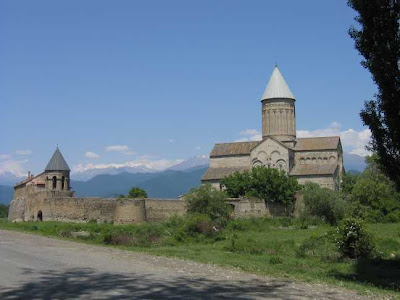Russian forces battle Georgians

A blog of Georgian wines, history and culture by Aaron R. Linderman
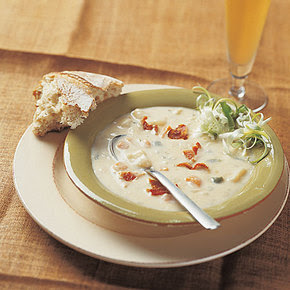 Today I discovered a wonderful blog of Georgian recipes, aptly titled Delicious Georgian Cuisine. I only regret that the blog had a rather short life and is no longer posting recipes. However, there are 48 on the website, and I'm looking forward to trying some. They run the gamut from soups and breads to meats and salads.
Today I discovered a wonderful blog of Georgian recipes, aptly titled Delicious Georgian Cuisine. I only regret that the blog had a rather short life and is no longer posting recipes. However, there are 48 on the website, and I'm looking forward to trying some. They run the gamut from soups and breads to meats and salads.
 The first two-story winery in recent Georgian history was built in Kakheti's Teliani valley in 1886; today, Teliani Valley PLC is heir to that tradition.
The first two-story winery in recent Georgian history was built in Kakheti's Teliani valley in 1886; today, Teliani Valley PLC is heir to that tradition.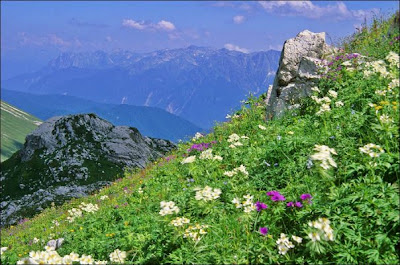
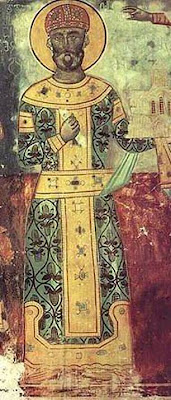 Since the 1080s the Kingdom of Georgia had been a tributary of the empire of the Seljuq Turks. In this dark time, known as the Great Turkish Onslaught (didi turkoba), young King David IV (left and below) decided he had had enough. He determined to bring order to the lawless land, reign in the unsubmissive feudal lords, centralize the state administration and build an army which could drive the Turks from Georgia and indeed the whole Caucasus.
Since the 1080s the Kingdom of Georgia had been a tributary of the empire of the Seljuq Turks. In this dark time, known as the Great Turkish Onslaught (didi turkoba), young King David IV (left and below) decided he had had enough. He determined to bring order to the lawless land, reign in the unsubmissive feudal lords, centralize the state administration and build an army which could drive the Turks from Georgia and indeed the whole Caucasus. Sultan Mahmud II of the Seljuqs did not look kindly upon King David's attempts to liberate his country and the sultan launched a major counteroffensive, lead by his brother and several leading officials of the empire. Islamic, Georgian, Armenian and Western European sources vary in their accounts, but all agree that the Seljuq army numbered somewhere between 200,000 and 600,000. King David’s had a mere 40,000 Georgians, 15,000 Kipchaks, 500 Alans and 100 Western "Franks." For every one man in his camp there was somewhere between three and ten in the enemy camp.
Sultan Mahmud II of the Seljuqs did not look kindly upon King David's attempts to liberate his country and the sultan launched a major counteroffensive, lead by his brother and several leading officials of the empire. Islamic, Georgian, Armenian and Western European sources vary in their accounts, but all agree that the Seljuq army numbered somewhere between 200,000 and 600,000. King David’s had a mere 40,000 Georgians, 15,000 Kipchaks, 500 Alans and 100 Western "Franks." For every one man in his camp there was somewhere between three and ten in the enemy camp.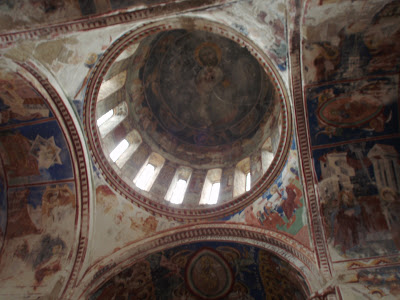 King David died on January 24, 1125, and was buried at the Gelati Monastery (whose ceiling is pictured above). As he requested, he was buried under the stones of the gatehouse, so anyone coming to visit would first step on his tomb, an act of great humility from such an accomplished man.
King David died on January 24, 1125, and was buried at the Gelati Monastery (whose ceiling is pictured above). As he requested, he was buried under the stones of the gatehouse, so anyone coming to visit would first step on his tomb, an act of great humility from such an accomplished man.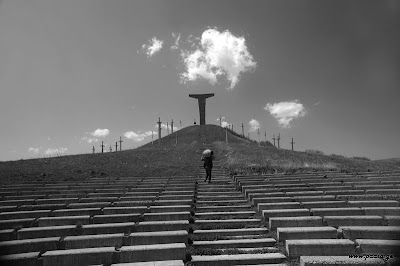 Memorial at Didgori
Memorial at Didgori
 Like many of Georgia's finest wines, Akhasheni red wine comes from the Kakheti region (whose David Gareja monastery is pictured above). This wine is made from Saperavi grapes from the Akhasheni vineyards of the Gurdzhaani district.
Like many of Georgia's finest wines, Akhasheni red wine comes from the Kakheti region (whose David Gareja monastery is pictured above). This wine is made from Saperavi grapes from the Akhasheni vineyards of the Gurdzhaani district.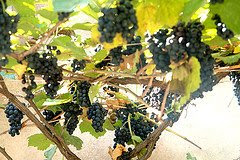 The wine is naturally semi-sweet and has a dark pomegranate color and a velvety taste with undertones of chocolate. It has 10.5-12.0% alcohol, 3-5% sugar and 5-7% titrated acidity. Akhasheni red wine has been manufactured since 1958.
The wine is naturally semi-sweet and has a dark pomegranate color and a velvety taste with undertones of chocolate. It has 10.5-12.0% alcohol, 3-5% sugar and 5-7% titrated acidity. Akhasheni red wine has been manufactured since 1958.
 Her command of the Georgian language was so excellent that when she wrote to Ilia Chavchavadze (pictured right) requesting permission to translate The Hermit, a copy of her letter was published in his newspaper, Iveria, as a model of style. When she arrived in Transcaucasia in December, 1894, she was received with great enthusiasm. On this and subsequent travels she met a wide variety of Georgians from every class and formed a number of lasting friendships which resulted in a regular and extensive correspondence in Georgian. “There is hardly a household in the Western Caucasus,” one commentator writes, “where her name is unknown. Others, have studied the language, literature, and history, of Georgia; she in addition felt an affection for the nation, kept herself informed of all that concerned its welfare, and was sometimes able unobtrusively to do good work for it.”
Her command of the Georgian language was so excellent that when she wrote to Ilia Chavchavadze (pictured right) requesting permission to translate The Hermit, a copy of her letter was published in his newspaper, Iveria, as a model of style. When she arrived in Transcaucasia in December, 1894, she was received with great enthusiasm. On this and subsequent travels she met a wide variety of Georgians from every class and formed a number of lasting friendships which resulted in a regular and extensive correspondence in Georgian. “There is hardly a household in the Western Caucasus,” one commentator writes, “where her name is unknown. Others, have studied the language, literature, and history, of Georgia; she in addition felt an affection for the nation, kept herself informed of all that concerned its welfare, and was sometimes able unobtrusively to do good work for it.”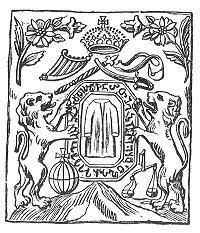 Though fragile and weak of body, Wardrop was known for her “subtle humor, strength of mind and warmth of heart.” On three successive occasions – in Port-au-Prince (1902), in St. Petersburg (1905), and in Bucharest (1907) – she found herself in the midst of war, but faced violence and pestilence with calm resolve, always sharing in the perils of those around her.
Though fragile and weak of body, Wardrop was known for her “subtle humor, strength of mind and warmth of heart.” On three successive occasions – in Port-au-Prince (1902), in St. Petersburg (1905), and in Bucharest (1907) – she found herself in the midst of war, but faced violence and pestilence with calm resolve, always sharing in the perils of those around her.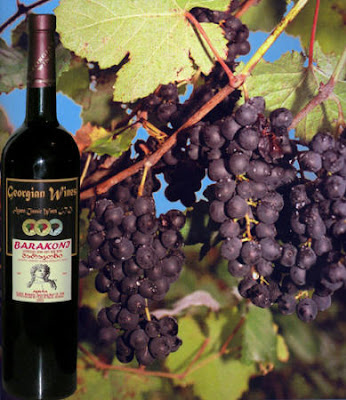 Barakoni red wine is grown on the steep slopes of the Rioni gorge in the mountainous western region of Racha (modern-day Racha-Lechkhumi and Kvemo Svaneti). This wine, made from Alexandreuli and Mudzhuretuli grapes (the same grapes from which Khvanchkara is made), is naturally semi-dry. Barakoni is known for its light-ruby color, fragrance of violets, natural pleasant sweetness and a tender harmonious taste. After breathing for a bit, Barakoni contains 10-12% alcohol, 1.5-2.5% sugar and has 5-7% titrated acidity.
Barakoni red wine is grown on the steep slopes of the Rioni gorge in the mountainous western region of Racha (modern-day Racha-Lechkhumi and Kvemo Svaneti). This wine, made from Alexandreuli and Mudzhuretuli grapes (the same grapes from which Khvanchkara is made), is naturally semi-dry. Barakoni is known for its light-ruby color, fragrance of violets, natural pleasant sweetness and a tender harmonious taste. After breathing for a bit, Barakoni contains 10-12% alcohol, 1.5-2.5% sugar and has 5-7% titrated acidity.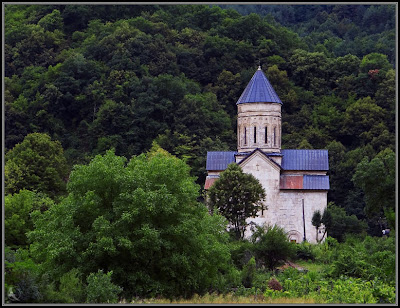
 A new edition of the Wardrop translation of the Georgian national epic, The Man in the Panther's Skin, by Shota Rustaveli (pictured left in a 1937 painting by Sergo Kobuladze) was released late last year in paperback form by Forgotten Books.
A new edition of the Wardrop translation of the Georgian national epic, The Man in the Panther's Skin, by Shota Rustaveli (pictured left in a 1937 painting by Sergo Kobuladze) was released late last year in paperback form by Forgotten Books.The history of the poem makes it worthy of perusal, for it has been in a unique manner the book of a nation for seven hundred years; down to our own days the young people learned it by heart; every woman was expected to know every word of it, and on her marriage to carry a copy of it to her new home. Such veneration shown for so long a period proves that the story of the Panther-clad Knight presents an image of the Georgian outlook on life, and justifies the presumption that merits tested by the experience of a quarter of a million days, most of them troublous, may be apparent to other races, that such a book may be of value to mankind, and chiefly to those peoples which, like the Georgian, came under the influence of Greek and Christian ideals.
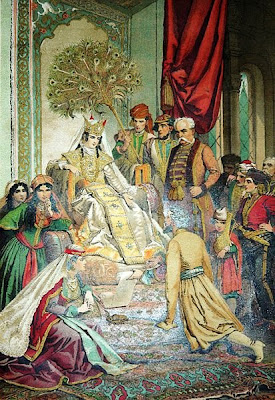 Shota Rustaveli presents his poem to Queen Tamar, Mihály Zichy, 1880s
Shota Rustaveli presents his poem to Queen Tamar, Mihály Zichy, 1880s
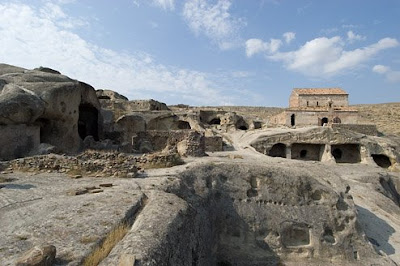 The name 'Uplistsikhe' (უფლისციხე) literally means 'the lord's fortress'; this ancient city on the Mtkvari River - complete with streets, churches, palaces, concert halls and living quarters - was carved out of the rock, beginning in the 5th century BC. Over the centuries, a unique combination of various architectural styles from Anatolia and Iran would emerge, with pagan and Christian structures eventually standing side by side.
The name 'Uplistsikhe' (უფლისციხე) literally means 'the lord's fortress'; this ancient city on the Mtkvari River - complete with streets, churches, palaces, concert halls and living quarters - was carved out of the rock, beginning in the 5th century BC. Over the centuries, a unique combination of various architectural styles from Anatolia and Iran would emerge, with pagan and Christian structures eventually standing side by side. Located just 10km east of modern-day Gori, Uplistsikhe is one of the oldest urban centers in Georgia and grew to be a key religious, political and cultural center in the Hellenistic period, in part due to its strategic location in the heartland of the Kingdom of Kartli (known as Iberia to the ancient writers).
Located just 10km east of modern-day Gori, Uplistsikhe is one of the oldest urban centers in Georgia and grew to be a key religious, political and cultural center in the Hellenistic period, in part due to its strategic location in the heartland of the Kingdom of Kartli (known as Iberia to the ancient writers).  The city rose to prominence again in the 9th century and became a stronghold during the Muslim conquests, until Genghis Khan destroyed the city in 1240. By the 14th century it was deserted.
The city rose to prominence again in the 9th century and became a stronghold during the Muslim conquests, until Genghis Khan destroyed the city in 1240. By the 14th century it was deserted. On April 29th the famed Erisioni dance company will premier its latest show, Samaia, in Bucharest. (As of this writing, tickets were still avaliable.) The performance takes its name from a traditional dance associated with Queen Tamar of Georgia, who is celebrated in the Georgian epic poem, The Knight in the Panther's Skin.
On April 29th the famed Erisioni dance company will premier its latest show, Samaia, in Bucharest. (As of this writing, tickets were still avaliable.) The performance takes its name from a traditional dance associated with Queen Tamar of Georgia, who is celebrated in the Georgian epic poem, The Knight in the Panther's Skin. If this latest show from producer Pascal Jourdan is anything like the last two, it will be well worth seeing. In addition, award-winning singer Marika Tkhelidze (pictured) will be performing with the troupe.
If this latest show from producer Pascal Jourdan is anything like the last two, it will be well worth seeing. In addition, award-winning singer Marika Tkhelidze (pictured) will be performing with the troupe.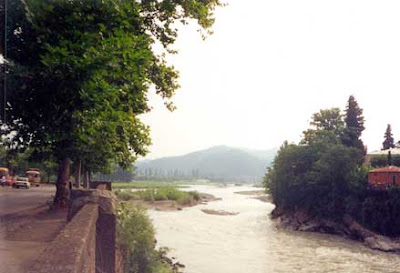 Made from Tsitska and Tsolikauri grapes, grown in the Imereti region, Lelo has a golden color, a fruity aroma and a well-balanced taste. (Incidentally, these are the same grapes used to make Kolkheti wine.)
Made from Tsitska and Tsolikauri grapes, grown in the Imereti region, Lelo has a golden color, a fruity aroma and a well-balanced taste. (Incidentally, these are the same grapes used to make Kolkheti wine.)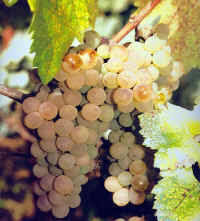 Similar in many ways to the port wines better known in the West, Lelo is a fortified wine, meaning that additional alcohol has been added. Originally this was done to presever the wine, though now it has become a matter of taste. Due to the added sweetness, such wines are sometimes referred to as "dessert wines."
Similar in many ways to the port wines better known in the West, Lelo is a fortified wine, meaning that additional alcohol has been added. Originally this was done to presever the wine, though now it has become a matter of taste. Due to the added sweetness, such wines are sometimes referred to as "dessert wines."